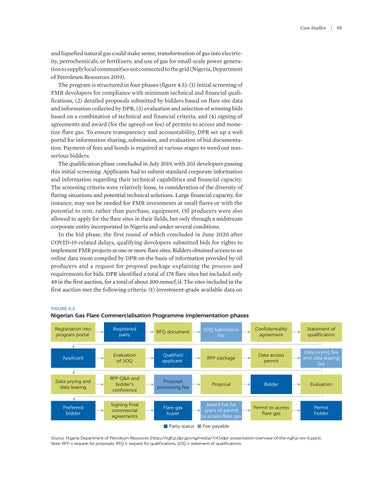Case Studies
|
95
and liquefied natural gas could make sense; transformation of gas into electricity, petrochemicals, or fertilizers; and use of gas for small-scale power generation to supply local communities not connected to the grid (Nigeria, Department of Petroleum Resources 2019). The program is structured in four phases (figure 4.5): (1) initial screening of FMR developers for compliance with minimum technical and financial qualifications, (2) detailed proposals submitted by bidders based on flare site data and information collected by DPR, (3) evaluation and selection of winning bids based on a combination of technical and financial criteria, and (4) signing of agreements and award (for the agreed-on fee) of permits to access and monetize flare gas. To ensure transparency and accountability, DPR set up a web portal for information sharing, submission, and evaluation of bid documentation. Payment of fees and bonds is required at various stages to weed out nonserious bidders. The qualification phase concluded in July 2019, with 203 developers passing this initial screening. Applicants had to submit standard corporate information and information regarding their technical capabilities and financial capacity. The screening criteria were relatively loose, in consideration of the diversity of flaring situations and potential technical solutions. Large financial capacity, for instance, may not be needed for FMR investments at small flares or with the potential to rent, rather than purchase, equipment. Oil producers were also allowed to apply for the flare sites in their fields, but only through a midstream corporate entity incorporated in Nigeria and under several conditions. In the bid phase, the first round of which concluded in June 2020 after COVID-19-related delays, qualifying developers submitted bids for rights to implement FMR projects at one or more flare sites. Bidders obtained access to an online data room compiled by DPR on the basis of information provided by oil producers and a request for proposal package explaining the process and requirements for bids. DPR identified a total of 178 flare sites but included only 48 in the first auction, for a total of about 300 mmscf/d. The sites included in the first auction met the following criteria: (1) investment-grade available data on FIGURE 4.5
Nigerian Gas Flare Commercialisation Programme implementation phases Registration into program portal
Registered party
RFQ document
SOQ submission fee
Confidentiality agreement
Statement of qualification
Applicant
Evaluation of SOQ
Qualified applicant
RFP package
Data access permit
Data prying fee and data leasing fee
Data prying and data leasing
RFP Q&A and bidder’s conference
Proposal processing fee
Proposal
Bidder
Evaluation
Preferred bidder
Signing final commercial agreements
Flare gas buyer
Award fee for grant of permit to access flare gas
Permit to access flare gas
Permit holder
Party status
Fee payable
Source: Nigeria Department of Petroleum Resources (https://ngfcp.dpr.gov.ng/media/1145/dpr-presentation-overview-of-the-ngfcp-rev-4.pptx). Note: RFP = request for proposals; RFQ = request for qualifications, SOQ = statement of qualifications.


